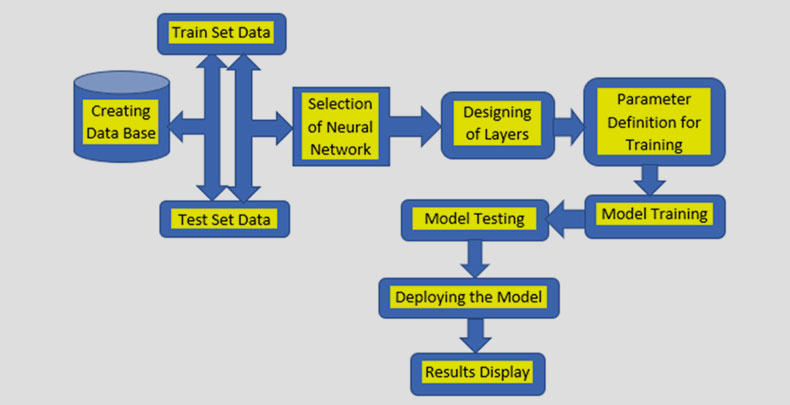
Introduction
The coronavirus (COVID-19), an unseen enemy of humanity, has created an unprecedented crisis to safeguard human lives since 2019. The impact has been devastating on the socio-economic fabric. In such a crisis, the challenge for humanity is to control, monitor, and decrease the spread of this unseen enemy. The death rates mainly depend on the timely treatment in curing the disease and highly necessitates an advance in the technological detection systems to serve the purpose. One that emphasizes the AI & ML algorithms with chest x-rays sample data to provide results faster than the existing system and with a minimal error rate and higher accuracy in monitoring the spread of COVID-19.
Algorithm
The application of Machine learning (ML) has been expeditiously increasing in several fields of science and technology, specifically for data manipulation and retrieval operations. The technology with a newly introduced effective image classification algorithm suitable for computer vision applications has proven more effective for newer challenges. These algorithms work on training concepts empowering the computational models and constitute numerous layers to understand the data representation with contemplation layers. The advanced layers that have proven all these possibilities are Deep Learning Network with Conventional Neural Network (CNN). This algorithm is proven to be most effective for Multimedia data. Focusing on the problem area, it utilizes the medical image data (X-ray) as an input. These images are mostly preferred because they provide more safety to the subject, quick response, and are convenient than the other image scanning methods.
ResNet-50
It is a classical neural network, grit for computer vision tasks of 50 layers deep. The trained version can facilitate loading a million images with the classification of object categorization in thousands.
Let us have the basic essential understanding of ResNet-50 elaborately known as Residual network. So, it is crucial to know the meaning of residual in the network scenario to understand the benefits of ResNet-50 over other traditional and ancient Networks used for the image data training.
In deep residual network training, it is crucial to learn the residual function F(x used in calculating the difference between the input and output. This differential understanding between input and output gives clarity about the residue responsible for incremental accuracy. It is equally crucial to learn about residue approaching zero, consequently generating optimal identity mapping. A general practice where other layers in the corresponding network outgrow the excellent feature maps. Preferably after the operations like convolving, pooling and activations. This consideration of optimal feature mapping poses’ admissible appearance in classifying the image data more effectively.
Key Features of ResNet-50
*ResNet adopts Batch Normalization at its foundation. Batch normalization takes care of the performance with the input layer adjustments to mitigate the covariant shift problem.
* To protect the network from vanishing gradient problems, ResNet makes use of the Identity Connection.
* The performance of the Deep Residual Network is increased with the utility of bottleneck residual block design.
Architecture of ResNet-50
The architectural information is essential for designing and understanding the network. ResNet architecture involves four stages. ResNet accepts the input image having height, width as multiples of 32, and a channel width of 3.
To understand, let us take the size of an input image as 224 x 224 x 3. Initial convolution is performed by all ResNet architectures and max-pooling with kernel sizes of 7×7 and 3×3, respectively. Stage1 of the network starts with the 3 residual blocks incorporating the 3 layers each. The size of the mask or kernel for performing convolution operation in all the three layers of the stage1 can commonly be 64 and 128 represented with identity connections and convolution operations. The input size will be minimized to half in terms of height and be doubled in the channel width by Residual Block performance with stride 2. The process of doubling the channel width and the input reduction by half is maintained as we process from one stage to another for deeper networks like ResNet50, ResNet152.
ResNet-50 essentially falls under the bottleneck design for each residual function (F) with smaller input/output dimensions. The three layers are defaced one over the other. Convolution layers are liable for shrinking the input/output image dimensions followed by an average polling network of 1000 neurons.
Uses
*Used for image modification processes like classification, localization, and detection of images.
*Applicable for Non-computer vision tasks in minimizing the computational expenses with the benefit of depth.
Workflow
Automation of the COVID-19 identification is a multistep sequential process, which comprises several modules. The ability of an algorithm depends on the success rate of each step to achieve highly efficient and accurate outputs.

Fig:1 Flow Diagram for Automatic Detection of COVID-19
The workflow is created to understand the sequence of the operational procedure in the detection of COVID-19. Fig:1 shows the flow diagram. The flow shows the database modifying the ResNet-50 network. The data grouping is followed by an appropriate neural network selection with a layer designing, training parameter definition (initial learning rate, the maximum number of epochs and batch size, etc.). With the above set of requirements, we train the model with testing, accuracy checking and deploying process to display the results with a suitable real-time hardware model to then further the enhancement of the project.
Further Enhancements
This basic model may give scope to most future researchers to further proceed with enhancements in terms of processing speed and additional features like sharing COVID information within minimum time to patients by using advanced communication systems and designing supportive electronic gadgets to save precious lives. The evaluation of the current system is done with disparate classifiers. The outstanding system may be enforced along with the assimilating alarm and notifying system soon. These arrangements may be interspersed with other features required to avoid the spread of the COVID-19 that can make an exemplary system to create a powerful impact on the spread.
Prof. Neelapala Anil Kumar
Assistant Professor
Alliance College of Engineering and Design